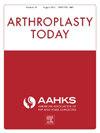Is Wear Still a Concern in Total Knee Arthroplasty With Contemporary Conventional and Highly Crosslinked Polyethylene Tibial Inserts in the mid- to Long-Term?
IF 1.5
Q3 ORTHOPEDICS
引用次数: 0
Abstract
Background
Modern literature has brought into question if wear of tibial inserts made from conventional or highly crosslinked polyethylene (HXL PE) is still a factor limiting longevity of total knee arthroplasty (TKA) in the mid- to long-term. It is the objective of this study to determine: 1) most common causes of mid- to long-term TKA failure, 2) the prevalence of delamination, and 3) the medial/lateral linear wear rates of conventional and HXL PE tibial inserts retrieved in the mid- to long-term.
Methods
A tibial insert retrieval cohort of 107 inserts (79 conventional, 28 HXL PE) with a minimum time in situ of 6.5 years (mean 11.7 ± 4) was studied. Failure causes were determined from chart-review, delamination presence was assessed microscopically, and medial/lateral linear wear was determined by minimal thickness changes measured with a dial-indicator.
Results
The most common mid-to long-term etiologies for failure were instability (44.9%), PE wear 15%), aseptic loosening (14%), and infection (13.1%). Delamination occurred in 70% of inserts (72.1% conventional, 64.3% HXLPE). Gross material loss due to delamination appeared to be the underlying reason for at least 33.3% of cases exhibiting instability. Of the cases removed for infection, 75% exhibited no histopathological hallmarks of acute infection. The medial/lateral wear rates were 0.054/0.051 (conventional) and 0.014/0.011 (HXL) mm/y, respectively.
Conclusions
Polyethylene wear still appears to be a major primary and secondary cause for TKA revision in the mid- to long-term. Wear may manifest as destabilizing delamination or as continuous release of fine wear particles potentially resulting in inflammatory responses and subsequent failure.
使用当代传统和高交联聚乙烯胫骨假体进行全膝关节置换术的中长期磨损问题仍然存在吗?
背景现代文献对传统或高交联聚乙烯(HXL PE)制成的胫骨假体的磨损是否仍然是限制全膝关节置换术(TKA)中长期使用寿命的一个因素提出了质疑。本研究的目的在于确定1) 中长期 TKA 失败的最常见原因;2) 分层的发生率;3) 中长期取回的传统和 HXL PE 胫骨假体的内侧/外侧线性磨损率。方法研究了一组取回的胫骨假体,共 107 个假体(79 个传统假体,28 个 HXL PE 假体),假体在原位的时间最短为 6.5 年(平均为 11.7 ± 4)。研究结果最常见的中长期失效原因是不稳定性(44.9%)、PE 磨损(15%)、无菌性松动(14%)和感染(13.1%)。70%的插入物出现分层(72.1%为传统插入物,64.3%为 HXLPE 插入物)。至少有 33.3% 的病例显示出不稳定性,其根本原因似乎是分层导致的材料大面积流失。在因感染而被移除的病例中,75%的病例没有表现出急性感染的组织病理学特征。内侧/外侧磨损率分别为0.054/0.051(传统)和0.014/0.011(HXL)毫米/年。磨损可能表现为不稳定的分层或细小磨损颗粒的持续释放,可能导致炎症反应和随后的失败。
本文章由计算机程序翻译,如有差异,请以英文原文为准。
求助全文
约1分钟内获得全文
求助全文
来源期刊

Arthroplasty Today
Medicine-Surgery
CiteScore
2.90
自引率
0.00%
发文量
258
审稿时长
40 weeks
期刊介绍:
Arthroplasty Today is a companion journal to the Journal of Arthroplasty. The journal Arthroplasty Today brings together the clinical and scientific foundations for joint replacement of the hip and knee in an open-access, online format. Arthroplasty Today solicits manuscripts of the highest quality from all areas of scientific endeavor that relate to joint replacement or the treatment of its complications, including those dealing with patient outcomes, economic and policy issues, prosthetic design, biomechanics, biomaterials, and biologic response to arthroplasty. The journal focuses on case reports. It is the purpose of Arthroplasty Today to present material to practicing orthopaedic surgeons that will keep them abreast of developments in the field, prove useful in the care of patients, and aid in understanding the scientific foundation of this subspecialty area of joint replacement. The international members of the Editorial Board provide a worldwide perspective for the journal''s area of interest. Their participation ensures that each issue of Arthroplasty Today provides the reader with timely, peer-reviewed articles of the highest quality.
 求助内容:
求助内容: 应助结果提醒方式:
应助结果提醒方式:


